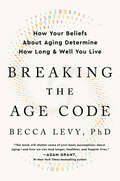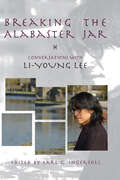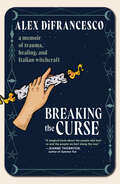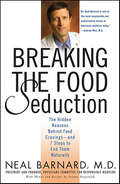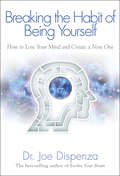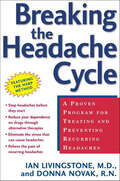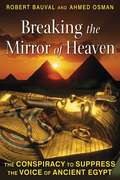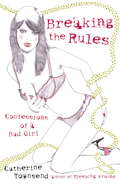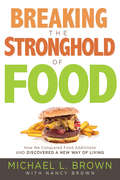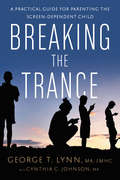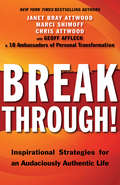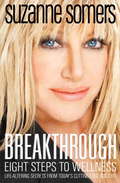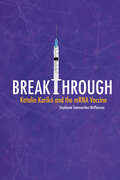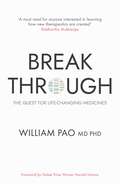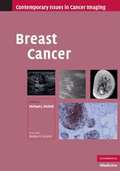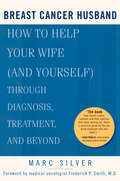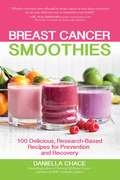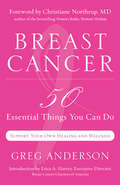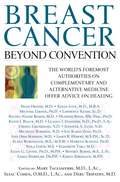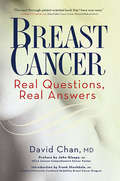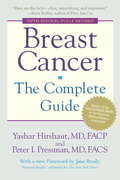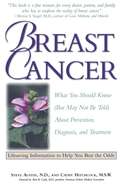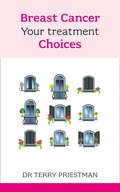- Table View
- List View
Breaking the Age Code: How Your Beliefs About Aging Determine How Long and Well You Live
by Becca Levy PhDYale professor and leading expert on the psychology of successful aging, Dr. Becca Levy, draws on her ground-breaking research to show how age beliefs can be improved so they benefit all aspects of the aging process, including the way genes operate and the extension of life expectancy by 7.5 years.The often-surprising results of Levy’s science offer stunning revelations about the mind-body connection. She demonstrates that many health problems formerly considered to be entirely due to the aging process, such as memory loss, hearing decline, and cardiovascular events, are instead influenced by the negative age beliefs that dominate in the US and other ageist countries. It’s time for all of us to rethink aging and Breaking the Age Code shows us how to do just that.Based on her innovative research, stories that range from pop culture to the corporate boardroom, and her own life, Levy shows how age beliefs shape all aspects of our lives. She also presents a variety of fascinating people who have benefited from positive age beliefs as well as an entire town that has flourished with these beliefs.Breaking the Age Code is a landmark work, presenting not only easy-to-follow techniques for improving age beliefs so they can contribute to successful aging, but also a blueprint to reduce structural ageism for lasting change and an age-just society.
Breaking the Alabaster Jar: Conversations with Li-Young Lee (American Readers Series)
by Li-Young LeeIn the foreword to Li-Young Lee&’s first book, Rose (BOA Editions, 1986), Gerald Stern wrote, &“What characterizes Li-Young Lee&’s poetry is a certain kind of humility, a kind of cunning, a love of plain speech, a search for wisdom and understanding. . . . I think we are in the presence of a true spirit.&” Poetry lovers agree! Rose has gone on to sell more than eighty thousand copies, and Li-Young Lee has become one of the country&’s most beloved poets. Breaking the Alabaster Jar: Conversations with Li-Young Lee is a collection of the best dozen interviews given by Li-Young Lee over the past twenty years. From a twenty-nine-year-old poet prodigy to a seasoned veteran in high demand for readings and appearances across the United States and abroad, these interviews capture Li-Young Lee at various stages of his artistic development. He not only discusses his family&’s flight from political oppression in China and Indonesia, but how that journey affected his poetry and the engaging, often painful, insights being raised a cultural outsider in America afforded him. Other topics include spirituality (primarily Christianity and Buddhism) and a wide range of aesthetic topics such as literary influences, his own writing practices, the role of formal and informal education in becoming a writer, and his current life as a famous and highly sought-after American poet.
Breaking the Curse: A Memoir about Trauma, Healing, and Italian Witchcraft
by Alex DiFrancescoA tour de force of narrative nonfiction, a reimagining of the self-help genre, and a brave memoir about mystical forces, trauma, trans life, and how we must heal ourselves to survive.For readers of memoirs by Elliot Page (Pageboy) and Elissa Washuta (White Magic), and fans of writers like Carmen Maria Machado, Samantha Hunt, and Chavisa Woods.In Breaking the Curse, Alex DiFrancesco takes their own crushing experiences of assault, addiction, and transphobic violence as the starting point for a journey to self-reclamation. Reeling in the aftermath of a rape that played out as painfully in public as in private, DiFrancesco begins to pursue spirituality in earnest, searching for an ancestral connection to magic as a form of protection and pathway to transformation. Propelled by a knowledge of the spiritual role of the transgender person in society, Alex winds through Cleveland and Brooklyn and Philly—from rehab and pagan AA meetings and friends&’ spare mattresses to tarot readers and books about Italian witchcraft to daily ritual, prayer, altar-making, and folk tradition. In so doing, they begin to not only piece together a way to heal but also call into existence a life that finally feels worth living. Breaking the Curse weaves spells, blasphemous novenas, and personal memories to imagine a new memoir form. Speaking about trauma does not always take its power away, DiFrancesco reminds us, but one can write their truth so that the hurt no longer fills the whole horizon."'I see this world as few others do,' writes Alex DiFrancesco, and thank goodness for that. In their memoir, Breaking the Curse, DiFrancesco offers readers a mesmerizing vision of this world and the workings of trauma, gender identity and magic within it. A spell-binding work."—Molly Roden Winter author of More: A Memoir of Open Marriage
Breaking the Food Seduction: The Hidden Reasons Behind Food Cravings—and 7 Steps to End Them Naturally
by Neal BarnardJennifer is a thirty-four-year-old bank manager. She's managed her education, her career, her finances--and her customers' money--she can't seem to handle this darn little chocolate in a shiny wrapper. . . Whether you're drawn to chocolate, cookies, potato chips, cheese, or burgers and fries, we all have foods we can't seem to resist--foods that sabotage our best efforts to lose weight and improve our health.These foods are winning the battle--but that's because we're fighting it in the wrong place. As physician and leading health researcher Dr. Neal Barnard explains in this groundbreaking book, banishing these cravings is not a question of willpower or psychology--it's a question of biochemistry. Based on the author's research and that of other leading investigators at major universities, Breaking the Food Seduction reveals the diet and lifestyle changes that can break these stubborn craving cycles. Using everyday examples, questionnaires, and practical tips, the book delivers:- Fascinating new insights into the chemical reasons behind your cravings- Seven simple steps to break craving cycles and tame your appetite- Important advice for kids' sugar cravings and how to halt them- A three-week kick-start program - One hundred delicious, satisfying recipes that help your body break the spell of problem foods and put you on the path to weight loss, better health, and greater well-beingThis accessible and practical book is essential reading for anyone who wants to lose weight, lower cholesterol, feel more energetic, and get control of their health once and for all.
Breaking the Habit of Being Yourself: How to Lose Your Mind and Create a New One
by Dr. Joe DispenzaDiscover how to reprogram your biology and thinking, and break the habit of being yourself so you can truly change your mind and life.Best-selling author, international speaker, chiropractor, and renowned researcher of epigenetics, quantum physics, and neuroscience, Dr. Joe Dispenza shares that you are not doomed by your genes and hardwired to be a certain way for the rest of your life.New science is emerging that empowers all human beings to create the reality they choose.In Breaking the Habit of Being Yourself, Dr. Joe Dispenza combines the fields of quantum physics, neuroscience, brain chemistry, biology, and genetics to show you what is truly possible and how to recondition the body and create better health.Not only will you be given the necessary knowledge to change your energy and any aspect of yourself, but you will be taught the step-by-step tools to apply what you learn in order to make measurable changes in any area of your life.Dr. Joe demystifies consciousness and ancient understandings to bridge the gap between science and spirituality. Through his powerful healing workshops and lectures, thousands of people in 24 different countries have used these principles to change from the inside out. Once you break the habit of being yourself and truly change your mind, your life will never be the same!&“In this book, I want to share some of what I learned along the way and show you, by exploring how mind and matter are interrelated, how you can apply these principles not only to your body, but to any aspect of your life.&”— Dr. Joe Dispenza&“Anyone who reads this book and applies the steps will benefit from their efforts. Its cutting-edge content is explained in a simple language that is accessible to anyone, and provides a user-friendly guide for sustained change from the inside out.&”— Rollin McCraty, Ph.D., Director of Research, HeartMath Research Center
Breaking the Headache Cycle: A Proven Program for Treating and Preventing Recurring Headaches
by Ian Livingstone Donna NovakTwo headache specialists offer their innovative Headache Reduction Program, for treating and preventing recurring headachesTwenty-eight million people in the United States suffer from chronic, recurrent, often disabling headaches-half of them forgoing medical attention in favor of analgesics that do nothing to prevent the next one. In Breaking the Headache Cycle , the authors-migraine sufferers themselves-present the integrated Headache Reduction Program (HARP) that they developed at the Princeton Headache Clinic. Based on the central insights that the predisposition to headaches is a sign of an unusually sensitive nervous system and that drugs are only one component of the most successful treatment plans, this remarkable program instructs readers in a range of techniques, including:- how to relieve the pain of migraines- how to detect and ward off oncoming headaches- how to prevent migraines from even threateningThe innovative solutions detailed in Breaking the Headache Cycle range from simple breathing exercises and dietary changes to support groups and the latest medications. In this thorough and accessible guide, the authors promise new relief for those already being treated for recurring headaches and for those who currently suffer in silence.
Breaking the Mirror of Heaven: The Conspiracy to Suppress the Voice of Ancient Egypt
by Robert Bauval Ahmed OsmanExposes the many cycles of monument destruction and cultural suppression in Egypt from antiquity to the present day • Details the vandalism of Egyptian antiquities and suppression of ancient knowledge under foreign rulers who sought to cleanse Egypt of its “pagan” past • Reveals the real reason behind Napoleon’s invasion of Egypt: Freemasonry • Shows how the censorship of nonofficial Egyptology as well as new archaeological discoveries continued under Antiquities Minister Zahi Hawass Called the “Mirror of Heaven” by Hermes-Thoth and regarded as the birthplace of civilization, science, religion, and magic, Egypt has ignited the imagination of all who come in contact with it since ancient times--from Pythagoras and Plato to Alexander the Great and Napoleon to modern Egyptologists the world over. Yet, despite this preeminence in the collective mind, Egypt has suffered considerable destruction over the centuries. Even before the burning of the Great Library at Alexandria, the land of the pharaohs was pillaged by its own people. With the arrival of foreign rulers, both Arabic and European, the destruction and thievery continued along with suppression of ancient knowledge as some rulers sought to cleanse Egypt of its “pagan” past. Exploring the many cycles of destruction and suppression in Egypt as well as moments of salvation, such as the first registered excavations by Auguste Mariette, Robert Bauval and Ahmed Osman investigate the many conquerors of Egypt through the millennia as well as what has happened to famous artifacts such as the Rosetta Stone. They show how Napoleon, through his invasion, wanted to revive ancient Egyptian wisdom and art because of its many connections to Freemasonry. They reveal how the degradation of monuments, theft of relics, and censorship of ancient teachings continue to this day. Exposing recent cover-ups during the tenure of Antiquities Minister Zahi Hawass, they explain how new discoveries at Giza were closed to further research. Clearing cultural and historical distortions, the authors reveal the long-hidden and persecuted voice of ancient Egypt and call for the return of Egypt to its rightful place as “the Mother of Nations” and “the Mirror of Heaven.”
Breaking the Rules: Confessions of a Bad Girl
by Catherine TownsendCat has got it on with all sorts of guys and if it has taught her one thing it is this: forget conventional rules and follow your heart's desires. When she hits her late twenties people start hassling her to settle down. But she treats this pressure to find a soulmate as a great excuse to test-drive a load of hot men. While she satisfies her constant sexual hunger, she begins to wonder what her ultimate destiny is. Her love-life is a rollercoaster ride of hot sex and heartbreak. But is the true path to 'happy ever after' channelled through lifelong monogamy or unbridled hedonism?
Breaking the Stronghold of Food: How We Conquered Food Addictions and Discovered a New Way of Living
by Michael L. BrownAre you sick and tired of being overweight? Are you fighting a losing battle with your waistline and eating yourself into the grave? Have you had it with feeling drained, discouraged, and run down because of obesity but find yourself enslaved to unhealthy eating habits?Are you convinced that God has a better way, but you simply can&’t break through? In their first-ever jointly authored book, Michael and Nancy Brown share the inspiring, practical, and humorous story of their own journey from obesity to vibrant health. If you want to break free from the stronghold of food and discover a wonderful new way of life, this book will show you the way.
Breaking the Trance: A Practical Guide for Parenting the Screen-Dependent Child
by Cynthia C. Johnson George T. LynnRecreational screen media use is quickly replacing family time, by no fault of parents. They are doing the best they can based on the information available to them, which claims nothing can be done to stop their children's screen dependence.Parents seeking change need a new framework for action. Breaking the Trance does not blame parents or vilify technology, but it does give parents clear and effective strategies to implement immediately. The results will restore a sense of care and connection within the family.George T. Lynn, MA, LMHC, is a psychotherapist from Bellevue, Washington, who has pioneered the use of psychotherapy for adults and children with neuropsychological issues. George is author of the Survival Strategies for Parenting series, Genuis! Nuturing the Spirit of the Wild Oppositional Child and The Asperger Plus Child. He has appeared on National Public Radio, Air America, and the Maury Povich Show to talk about his work with children who exhibit extreme behavior problems.Cynthia C Johnson, MA, utilizes in-home individualized therapeutic tutoring to help unique K-12 learners reach their full potential. She is the founding director of the Venture Program at Bellevue College in Washington, the first degree program in the nation designed for students challenged with learning and intellectual disabilities. Her work has been featured by National Public Radio, the Chicago Tribune, Inside Higher Education, University Business Magazine, the Seattle Times, and KIRO 7. She is a Certified Mediator Practitioner in Washington State.
Breakthrough!: Inspirational Strategies for an Audaciously Authentic Life
by Marci Shimoff Janet Bray Attwood Chris Attwood Geoff Affleck 18 Ambassadors of Personal TransformationBreakthrough Your Barriers and Dare to Live an Authentic Life <P><P> You can live the life of your dreams, and Breakthrough! Inspirational Strategies for an Audaciously Authentic Life will show you how. Learn the secret that New York Times bestselling authors Janet Bray Attwood, Marci Shimoff, Chris Attwood, and 18 other experts know: you can consciously create the life you’ve always wanted. <P> Here you will find 22 strategies using wit, deep-insight, and heart-centered wisdom to empower you with the knowledge and motivation to create a life of abundance, happiness, health, and love. Covering topics from career to relationships to personal transformation, this international dream team of authors will show you how to finally breakthrough and live the life you were born to live. <P> No matter what your circumstances, there is a way to make a change, and this book will be your guide. You will find the inspiration and tools to create a life that is audaciously authentic in every way. <P> Contributors: Roger Seip, Ellen Rogin, Nancy Falconi, Gina Calvano, Susie Steadman, Jane Cavanaugh, Una Panting, Dr. Shannon South, Cliff Thomas MD, Shan McLean, Scott Werner, Leslie A. Klocek Pencak, Barbara Edie, Inger Pols, Josephine Auicello, Mary Knight, Maggie Dillon Katz, Wendy Nichols
Breakthrough: Eight Steps to Wellness -- Life-altering Secrets from Today's Cutting-edge Doctors
by Suzanne SomersToday's most trusted advocate of antiaging medicine, Suzanne Somers, deepens her commitment to helping people lead healthier, happier lives by opening their eyes to cutting-edge, proven remedies and preventative care that most doctors just aren't talking about with patients: longevity medicine and the more progressive study of bioidentical hormones. As we age, certain hormones diminish, creating an imbalance that can set off everything from perimenopause to cancer, beginning as early as our thirties. This hormonal imbalance is causing many to feel depressed, anxious, fatigued, sexless, sleepless, and ultimately ill, sometimes even terminally. What's more, Somers and twenty doctors in the field of anti-aging medicine argue that the processed chemicals in foods and pharmaceuticals we ply ourselves with are actually slowly eroding our bodies and minds. So we're getting slammed twice. From estrogen dominance to deceptive thyroid problems, people are suffering, and most don't have access to the treatment they truly need to get better and thrive ... until now. Breakthrough explores cutting-edge science and delivers smart, proactive advice on the newest treatments for breakthrough health and longevity.In addition to being a pioneer in a rapidly growing health field, Somers is a passionate, caring individual whose own life was derailed by disease and brought back to unimaginable, feel good heights that she wants you, too, to experience.
Breakthrough: Katalin Karikó and the mRNA Vaccine
by Stephanie Sammartino McPhersonA thorough and accessible biography of Dr. Katalin Karikó, winner of the 2023 Nobel Prize in Physiology or Medicine, whose hard work pioneering mRNA research led to the COVID-19 vaccines. Her monumental contribution to global health care has rightfully placed Karikó as one of the most important scientists in history. She has won awards, given speeches, and appeared in magazines and television programs. But she wasn’t always famous—in fact, it took decades for anyone to recognize the importance of her research into RNA and the potential of mRNA to help cells fight off disease. Beginning with her birth in a small village in rural Hungary, Breakthrough tells the story of how a young girl interested in the wildlife around her became an internationally celebrated hero. Exuberant, devoted to her family, and hard-working, Karikó persevered in the face of challenges and obstacles that would have discouraged many of her peers. Her achievements remind us that if we believe in ourselves, no matter the setbacks we encounter, we can succeed.
Breakthrough: The Quest for Life-Changing Medicines
by Dr William PaoMeet the doctors, scientists, patients and campaigners tackling the world&’s worst diseases We often hear about the dark side of the pharmaceutical industry – from extortionate pricing to the opioid epidemic. But there&’s another story to be told. Through the story of eight revolutionary treatments, Dr William Pao cuts to the innovative heart of medical science and celebrates the tireless work of those fighting for better care. Behind each of these medicines – whether a potentially life-saving new treatment for cancer, or something as commonplace as paracetamol – there stands a cast of characters and a wealth of stories. The trajectory from the laboratory to the local chemist is rarely a straight line. Eureka moments are few are far between. Drug hunting demands leaps of imagination and lateral thinking, the accumulation of the knowledge and expertise of many, and – nearly always – a hefty dollop of luck. Breakthrough documents these journeys and grants a privileged look at the stories behind the medicines that improve – and very often save – our lives.
Breast Cancer
by Michael Michell Rodney H. Reznek Janet E. HusbandWorldwide, breast cancer is by far the most common cancer amongst women, with an incidence rate more than twice that of colorectal cancer and cervical cancer and about three times that of lung cancer. Whilst screening programmes have improved detection, this disease still places a very high burden on healthcare services worldwide. Over the last two decades, improved public awareness, the implementation of population screening by mammography, and the development of new technology for diagnosis have transformed the care of patients with breast cancer. In this volume, recognized experts discuss key current issues in the diagnosis and management of breast disease. The development and application of new diagnostic techniques is described as well as the use of sophisticated drugs for more effective treatment. Complex contentious topics including risk factors, borderline lesions, professional performance and quality assurance are thoroughly explored by an expert multidisciplinary team.
Breast Cancer Basics And Beyond
by Delthia Ricksall aspects of breast cancer covered here, discovery, treatmentt, surgeries of all types, frank patients opinions of cancer treatment, and at the end of the book is a list of resources to help all cancer patients. A must read for all women, and families dealing with breast cancer.
Breast Cancer Husband: How to Help Your Wife (and Yourself) during Diagnosis, Treatment and Beyond
by Marc SilverA unique guide, like none other on the market-packed with medical information, practical tips, psychological insight, and coping strategies--to help men help the women they love through this trying time.When Marc Silver became a breast cancer husband three years ago, he learned firsthand how frightened and helpless the breast cancer husband feels. He searched in vain for a book that would give him the information and advice he so desperately sought. Now this award-winning journalist has compiled just the kind of emotionally supportive and useful resource that he wished he had been able to consult-to give men the tools they need to help their wives, their families, and themselves through this scary, uncertain time.In his years as a consumer journalist and veteran of the News You Can Use staff at U.S. News & World Report, Marc Silver learned what kind of information and advice on medical crises readers found most valuable. He draws on that experience as he covers in depth all the issues couples coping with breast cancer will have to face during diagnosis, treatment, and beyond. Highlights include: - The shared experiences of other breast cancer husbands- Guidance from top cancer doctors in the country- Advice on when, how, and what to tell your young children- Tips on coping with radiation and chemotherapy - A candid discussion of sex and intimacy following breast cancer surgeryMore than 200,000 women are diagnosed with cancer each year in the United States. At last, with this book, the men who love them have a road map to help them through a difficult and unprecedented journey.
Breast Cancer Smoothies: 100 Delicious, Research-Based Recipes for Prevention and Recovery
by Daniella ChaceThe statistics are staggering. Breast cancer is the most common type of cancer among women--About 1 in 8 U.S. women (about 12%) will develop invasive breast cancer over the course of her lifetime. Second only to heart disease by a mere one percent, every ounce of prevention and every window of opportunity for healing is critical. In order to reduce the risk of developing this common disease, you need a targeted plan to protect yourself from common breast toxins and to strengthen your immune defenses. In her delightful new book, Daniella breaks down the complex topic of oncology nutrition and the specific dietary needs breast cancer creates, into simple recommendations for making delicious smoothies that support healing and a healthy lifestyle. What makes 100 Breast Cancer Smoothies unique? An extensive body of research, that provides many of our long-sought answers to the cause of breast cancer, has been translated into simple, healthy smoothie recipes! It's all about Daniella's nutrient-rich, whole-foods recipes created only from ingredients that provide a direct benefit to fighting breast cancer. Concentrated amounts of carotenoids, flavonoids, probiotics, protein and minerals, including bioactive compounds from herbs and citrus oils dramatically reduce the development and spread of breast cancer cells. Color photos styled by the award-winning photographer Olivia Brent charm the pages with luscious smoothies images. Each recipe includes tips about the food nutrients that effect breast cancer in direct ways, including reducing cancer cell development, growth and spread. With just a few minutes each day, you can dramatically change the course of your life by working to prevent and heal breast cancer through fresh, appealing drinks. Living well never tasted soooo good!
Breast Cancer Treatment Handbook
by Judy C. KneeceBreast Cancer Treatment Handbook: Understanding the Disease, Treatments, Emotions, and Recovery From Breast Cancer written by a survivor, Judy C. Kneece, RN, OCN.
Breast Cancer: 50 Essential Things You Can Do
by Greg AndersonThe founder of the Cancer Recovery Foundation presents an essential guide to facing breast cancer with a combination of healing tactics.While recovery and survival rates for breast cancer have improved, the shock and confusion that comes with a diagnosis remains overwhelming, as does choosing a plan of treatment. With so many options out there, it’s difficult to know the best option for you. This is where an integrated approach comes in. By using a variety of tools, you maximize opportunity for healing.As a recognized pioneer in the field of integrated cancer care, Greg Anderson offers critical information and advice about the major issues facing breast cancer patients. As someone who has been a cancer patient himself, he also knows the emotional turmoil and stress a diagnosis can cause. Because of this, he guides readers toward making a concrete, comprehensive recovery plan that combines nutrition, exercise, mind/body approaches, and social support along with conventional medical care.Breast Cancer: 50 Essential Things to Do offers:A guide to health and healing from one of the world’s leading wellness authoritiesAn approach to recovery that calls into question Western medicine’s tendency to overtreatAdvice for cultivating physical, emotional, and spiritual health
Breast Cancer: Beyond Convention
by Mary Tagliaferri Debu Tripathy Isaac CohenToday, more breast cancer treatment options are available than ever before. But how can you determine the course of action that is right for YOU? Breast Cancer: Beyond Convention is the only single resource that lays out all of the traditional and alternative approaches available today. Assembling a "dream team" of breast cancer experts, the editors of this truly groundbreaking guide encourage readers to work with their practitioners as they consider a variety of approaches, all explained in clear, nontechnical language. Readers will discover how to find the right caregiver and how to best complement conventional medical treatment with alternative medicine how to be "healed" without necessarily being "cured" how to incorporate traditional Chinese medicine -- including herbs, qigong, and acupuncture the right diet to choose, no matter the form of treatment; the importance of soy products; plus fifteen delicious recipes to sample the best vitamins, minerals, and natural foods, and the specific benefits -- and possible dangers -- of each the merits of spiritual treatments, from meditation and directed prayer to the powerful mystery of the "will to live." The guide features an encyclopedic appendix of websites, and lists of national support organizations, care centers, recommended audiotapes, CDs, and books -- making this the single source to help patients take control of their treatment, assuage their fears, and get them on the road to healing. A portion of the proceeds from the sale of this book will be donated to the Carol Franc Buck Breast Care Center Complementary and Alternative Medicine Program at the University of California, San Francisco
Breast Cancer: Real Questions, Real Answers
by David ChanBreast Cancer: Real Questions, Real Answers is an outgrowth of Dr. David Chan's more than 20 years in private oncology practice. Inspired by his patients—who courageously face their illness but often feel fearful, confused about their options, and full of questions—Dr. Chan's book is uniquely structured as a Question and Answer between patient and doctor.<P><P> It provides readers with an easily navigated, completely current resource for all of their queries. Poised to become the new must-read for breast cancer patients, this book offers easily digestible information by reviewing and exploring the causes of breast cancer, outlining the core basics of breast cancer therapy, explaining how breast cancer survival is influenced by lifestyle, and much more. Dr. Chan's surefooted, compassionate tone offers reassurance throughout, as do the stories of his many patients, which give readers a firsthand glimpse at what they may face down the road, all from a survivor's point of view. Complete with a glossary of important terms and an appendix of useful resources, Breast Cancer: Real Questions, Real Answers is a must for every breast cancer patient seeking information that will guide her through her struggle toward a triumphant recovery.
Breast Cancer: The Complete Guide
by Yashar Hirshaut Peter I. PressmanWritten by two renowned authorities who specialize in the treatment of breast cancer, a surgeon and an oncologist, this lucid step-by-step guide has established itself as the indispensable book women need to make informed decisions about the care that is right for them. Breast cancer will strike one out of every eight women in the United States. Because there have been many important changes in the diagnosis and treatment of breast cancer in the last few years, this fully revised Third Edition contains information on the latest developments in the field, including: * new diagnostic procedures * changes in the treatment of in situ cancer * improved surgical techniques * gene testing * sequencing radiation and chemotherapy * HER-2Neu (Herceptin) * tamoxifen for prevention * bone marrow and stem cell transplants * and more
Breast Cancer: What You Should Know (But May Not Be Told) About Prevention, Diagnosis, and Treatment
by Steve Austin Cathy Hitchcock"This book is a fine resource for every doctor, patient, and family who has to confront the reality of breast cancer."--Bernie S. Siegel, M.D., Author of Love, Medicine, and MiraclesAttitudes about breast cancer diagnosis are changing, and women and their families are becoming more assertive about managing their disease. They know that more choices are available now than ever before, and they are willing to make them. This book encourages you to take control. Cathy Hitchcock and Steve Austin, N.D., have written a book for women who are ready to actively participate in their diagnosis and treatment. A husband and wife team, Hitchcock and Austin walk you step-by-step through each part of diagnosis, treatment (both conventional and alternative), and prevention (including prevention of a recurrence). With the help of a flow chart, they examine different diagnosis options. They also suggest questions to ask your doctor and offer checklists, summaries, and overviews. Interwoven with all this information, Cathy shares her personal story as a breast cancer survivor. She describes her ordeal upon discovering the lump and the transitions she has gone through to live with the diagnosis in a life-affirming way. Unlike many other breast cancer patients, Cathy didn't simply accept the choices offered by medical doctors. Instead, with the help of her husband, she studied the research and made her own decisions about conventional and alternative treatments.From the Trade Paperback edition.
Breast Cancer: Your Treatment Choices
by Terry J. PriestmanThe basic information needed to make informed choices about cancer care is covered in this book, including key facts about surgery, radiotherapy, chemotherapy, hormone therapy, targeted therapy and complementary treatments. There is also advice regarding advanced breast cancer.
